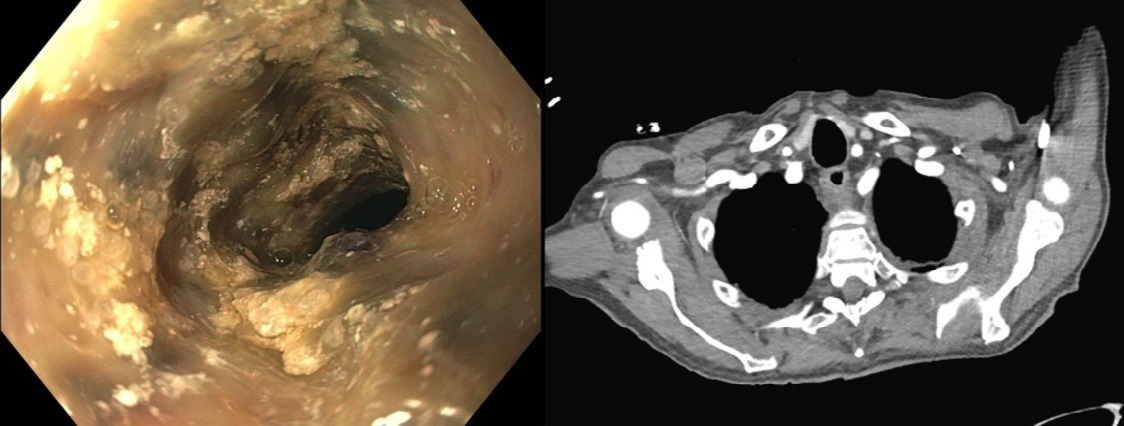Back


Poster Session B - Monday Morning
Category: Esophagus
B0239 - Black Esophagus Due to Severe SARS-CoV2 Infection
Monday, October 24, 2022
10:00 AM – 12:00 PM ET
Location: Crown Ballroom

Has Audio
- SP
Syed Bilal Pasha, MD
University of Missouri
Columbia, MO
Presenting Author(s)
Hamza Ertugrul, MD1, Syed Bilal Pasha, MD1, Omer Basar, MD1, Harleen K. Chela, MD2, Ebubekir Daglilar, MD1
1University of Missouri, Columbia, MO; 2University of Missouri-Columbia, Columbia, MO
Introduction: Acute esophageal necrosis (AEN), also called ‘black esophagus’ due to its appearance is a rare clinical disease, recently described in medical literature. The etiology is multifactorial, often in the setting of severe systemic conditions such as sepsis and trauma, and outcomes are poor. Severe SARS-CoV2 infection can lead to overwhelming inflammation and multi-organ failure. Herein, we present a case of black esophagus with severe SARS-CoV2 infection.
Case Description/Methods: A 69-year-old with rheumatoid disease, on immune suppression, was admitted to our hospital with dyspnea, coffee ground emesis and melena. He tested positive for SARS-CoV2 and was found to have acute blood loss anemia. An urgent EGD was performed which revealed a black, necrotic mucosa of the distal 2/3rd of the esophagus, consistent with AEN. Biopsies were avoided due to risk of perforation and subsequent images were negative for any perforation.
Management was started with high dose PPI and supportive care in addition to recognized treatment for COVID-19. However, his hospital stay became complicated with progressive clinical decline and development of multi-organ failure. Eventually, he was transitioned to comfort care and passed away shortly after.
Discussion: AEN or black esophagus, as defined by its endoscopic appearance, is a manifestation of ischemic and corrosive injury to the esophagus in the setting of severe systemic disease processes. Diffuse, circumferential, necrotic and friable esophageal mucosa, especially in the distal 2/3rd, is the hallmark. The relatively poor vascular supply of the distal esophagus makes it more susceptible to such injury. Often, a sharp demarcation is seen at the Z-line. Histology shows extensive transmural necrosis.
Pathogenesis of AEN is thought to be a combination of a sudden low flow, prothrombotic state from severe systemic illness causing ischemic injury and impaired healing ability. At the same time, increased exposure to gastric content occurs from gastric hypokinesis and increased secretions which exacerbate injury.
Typical presentation is upper GI bleed, and management revolves around treatment of underlying etiology and supportive measures with acid suppression and mucosal protection with PPI and sucralfate. NG tubes should be avoided due to risk of perforation, which is the most serious complication. Surgical intervention is reserved for perforation, and balloon dilation can be required in cases of stenosis or strictures.

Disclosures:
Hamza Ertugrul, MD1, Syed Bilal Pasha, MD1, Omer Basar, MD1, Harleen K. Chela, MD2, Ebubekir Daglilar, MD1. B0239 - Black Esophagus Due to Severe SARS-CoV2 Infection, ACG 2022 Annual Scientific Meeting Abstracts. Charlotte, NC: American College of Gastroenterology.
1University of Missouri, Columbia, MO; 2University of Missouri-Columbia, Columbia, MO
Introduction: Acute esophageal necrosis (AEN), also called ‘black esophagus’ due to its appearance is a rare clinical disease, recently described in medical literature. The etiology is multifactorial, often in the setting of severe systemic conditions such as sepsis and trauma, and outcomes are poor. Severe SARS-CoV2 infection can lead to overwhelming inflammation and multi-organ failure. Herein, we present a case of black esophagus with severe SARS-CoV2 infection.
Case Description/Methods: A 69-year-old with rheumatoid disease, on immune suppression, was admitted to our hospital with dyspnea, coffee ground emesis and melena. He tested positive for SARS-CoV2 and was found to have acute blood loss anemia. An urgent EGD was performed which revealed a black, necrotic mucosa of the distal 2/3rd of the esophagus, consistent with AEN. Biopsies were avoided due to risk of perforation and subsequent images were negative for any perforation.
Management was started with high dose PPI and supportive care in addition to recognized treatment for COVID-19. However, his hospital stay became complicated with progressive clinical decline and development of multi-organ failure. Eventually, he was transitioned to comfort care and passed away shortly after.
Discussion: AEN or black esophagus, as defined by its endoscopic appearance, is a manifestation of ischemic and corrosive injury to the esophagus in the setting of severe systemic disease processes. Diffuse, circumferential, necrotic and friable esophageal mucosa, especially in the distal 2/3rd, is the hallmark. The relatively poor vascular supply of the distal esophagus makes it more susceptible to such injury. Often, a sharp demarcation is seen at the Z-line. Histology shows extensive transmural necrosis.
Pathogenesis of AEN is thought to be a combination of a sudden low flow, prothrombotic state from severe systemic illness causing ischemic injury and impaired healing ability. At the same time, increased exposure to gastric content occurs from gastric hypokinesis and increased secretions which exacerbate injury.
Typical presentation is upper GI bleed, and management revolves around treatment of underlying etiology and supportive measures with acid suppression and mucosal protection with PPI and sucralfate. NG tubes should be avoided due to risk of perforation, which is the most serious complication. Surgical intervention is reserved for perforation, and balloon dilation can be required in cases of stenosis or strictures.

Figure: Diffuse necrotic appearing esophagus with black discoloration on EGD
Dilated esophagus with diffuse esophageal wall thickening on CT
Dilated esophagus with diffuse esophageal wall thickening on CT
Disclosures:
Hamza Ertugrul indicated no relevant financial relationships.
Syed Bilal Pasha indicated no relevant financial relationships.
Omer Basar indicated no relevant financial relationships.
Harleen Chela indicated no relevant financial relationships.
Ebubekir Daglilar indicated no relevant financial relationships.
Hamza Ertugrul, MD1, Syed Bilal Pasha, MD1, Omer Basar, MD1, Harleen K. Chela, MD2, Ebubekir Daglilar, MD1. B0239 - Black Esophagus Due to Severe SARS-CoV2 Infection, ACG 2022 Annual Scientific Meeting Abstracts. Charlotte, NC: American College of Gastroenterology.
